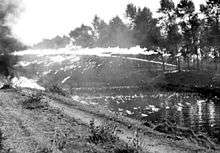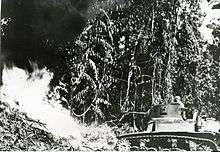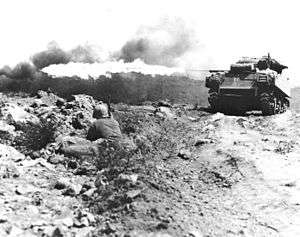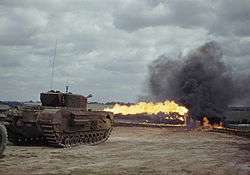Flame tank

A flame tank is a type of tank equipped with a flamethrower, most commonly used to supplement combined arms attacks against fortifications, confined spaces, or other obstacles. The type only reached significant use in the Second World War, during which the United States, Soviet Union, Germany, Italy, Japan and the United Kingdom (including members of the British Commonwealth) all produced flamethrower-equipped tanks.
A number of production methods were used. The flamethrowers used were either modified versions of existing infantry flame weapons (Flammpanzer I and II) or specially designed (Flammpanzer III). They were mounted externally (Flammpanzer II), replaced existing machine gun mounts, or replaced the tank's main armament (Flammpanzer III). Fuel for the flame weapon was either carried inside the tank, in armoured external storage, or in some cases in a special trailer behind the tank (Churchill Crocodile).
Flame tanks are generally considered obsolete. No new models have been built since 1962, and their last use in any army was in 1974.
Combat effectiveness
In comparison to man-portable flamethrowers, flame tanks carried much more fuel, and could fire longer-ranged bursts. Due to their ability to get in range of enemy positions in comparative safety, they were invaluable for rooting out heavy infantry fortifications. For example, as no US tank cannon could possibly penetrate the thick bunkers[1] created by the Japanese defenders on islands such as Tarawa or Iwo Jima, flame throwing tanks were used instead, while infantrymen provided the necessary security during their deployment.
The maximum range of a flamethrower was typically less than 150 metres. Because of this limitation, the flamethrower was virtually useless on an open battlefield. However, they proved a potent psychological weapon against fortified troops. In many instances, troops surrendered or fled upon seeing a flame tank fire ranging shots, rather than risk being burned alive.
Experience of combat use of flamethrower tanks was mixed. German flamethrower variants of Panzer II and Panzer III were both discontinued due to unsatisfactory performance and converted into assault guns or tank destroyers. The Panzer IV was never converted into a flame variant, despite having been configured for many other roles.
The mixed results were in part due to the development of infantry anti-tank weapons. At the start of the Second World War most infantry units had weapons with some effectiveness against armoured targets at ranges of thirty to fifty meters, like anti-tank rifles. Towards the end of the war, more powerful anti-tank weapons such as the bazooka, Panzerschreck, and PIAT were introduced which were fatal to tanks at ranges longer than the tank's flamethrower could reach.
While the British used a squadron of Churchill Crocodiles during the fighting at Brest in September 1944, the US Army received a smaller American designed flamethrower mounted upon the M4 Sherman tank during the same month. Assigned to the US Army's 70th Tank Battalion, the flamethrowing tanks went into action on 18 September 1944, where it was found that the weapons had a very short range as compared to the British Crocodiles, and consequently were not very popular amongst US troops.[2]
The Canadian and Dutch armies became two of the most active users of the Wasp flamethrowers while fighting in Europe, finding the weapons to be extremely effective in prying German soldiers from their defenses. Indeed, the mechanical flamethrowers, although not impressive by themselves, struck horror into the minds of German troops, who feared them more than any other conventional weapon.[3] Canadian troops used them during the Battle of the Scheldt.

Crews of 'flame' tanks were not necessarily more vulnerable than those crews in the regular, standard version of the tank (a Churchill 'Crocodile' flame tank being more or less as vulnerable to anti-tank weapons as the standard Churchill), but the crews of flamethrowing tanks were often treated differently should they be captured alive by enemy troops. Due to the perceived inhumanity of the weapon itself, captured crews of such tanks were often treated much less humanely than crews of regular tanks. Instances of 'flametankers' being executed by the opposite troops upon capture were not uncommon. Subsequently, British tank crews received sixpence a day extra 'danger money' due to the threat of arbitrary execution.[4] Flame tanks also suffered from the fact, along with flamethrower-armed troops, that all enemy within range would usually open up on them due to the fear of the weapon.[5]
Flame tanks were not necessarily more prone to catching fire or exploding, unless hit with an armor piercing round or explosive reaching the ammunition and fuel inside. Tanks such as the Churchill 'Crocodile', which towed the liquid container behind the actual tank, held no greater risk of fire than standard tanks. Although the towed container itself could be easily targeted, the tank and its crew were generally well protected.
World War II Axis
German Army
- Flammpanzer I a field variant of the German Panzer I used briefly during the war in North Africa
- Panzer II Flamm, a variant of the German Panzer II Ausf D/E.
- Flammpanzer 38, a variant of the Jagdpanzer 38(t) tank destroyer.
- Panzerkampfwagen B2 (F), a variant produced by the Germans based on captured French Char B1 tank chassis.
- Flammpanzer III Ausf. M/Panzer III (Fl), a variant of the German Panzer III Ausf. M.
- Sdkfz 251/16 Flammpanzerwagen, a variant based on the Sdkfz 251 series of half-tracks.
- StuG III (Flamm), a variant based on a variety of pre-Ausf F StuG III assault gun chassis.
Italian Royal Army (Regio Esercito)
- L3 Lf flame tank, a variant of the L3/35 tankette.
- L6 Lf flame tank, a variant of the L6/40 light tank.
Imperial Japanese Army
- Japanese Army Type "SS" Armored Engineer Vehicle Models Bo,Ko,Otsu,Hei,Tei
- Flame tank model of Type 95 Ha-Go Tank.
World War II Allied
Light Tank M3 (General Stuart)

- M3 Satan: Improvised conversion of M3 light tank with Canadian "Ronson".[6]
Medium Tank M4 (General Sherman)

- M4A3R3 "Zippo": Sherman tank used during the Battle of Iwo Jima (1945)
- M4 "Crocodile": four M4 tanks converted by British for US 2nd Armored Division in NW Europe with the same armored fuel trailer as used on Churchill but the fuel line went over the hull.
- Sherman Badger: Canada's replacement of its Ram Badger, the Sherman Badger was a turretless M4A2 HVSS Sherman with Wasp IIC flamethrower in place of hull machine gun, developed sometime from 1945 to 1949. The 150 gallons at 250 psi was effective to 125 yards, with elevation of +30 to -10 degrees and traverse of 30 degrees left and 23 degrees right. This inspired the US T68.[7]
- Sherman Adder: A conversion kit to equip Sherman tanks, used in India on Sherman III and Sherman V
Tank, Infantry, Mk IV "Churchill"

- Churchill OKE: Churchill Mk II with fixed "Ronson" flamethrower. Three were part of the 1942 Raid on Dieppe but were put out of action before the equipment was used.
- Churchill Crocodile: Churchill Mk VII equipped with a kit including an armored fuel trailer that used compressed nitrogen for pressure. The flamethrower replaced the hull machine gun leaving the main armament unaffected. Eight hundred conversion kits were produced. Operating under the organization of the 79th Armoured Division, as with other specialised vehicles, it was deployed following the 1944 Normandy landings in north-west Europe and in the Italian campaign. It could deliver eighty 1-second bursts out to 120 yards (110 m) before refuelling.
Tank, Infantry, Mk II, Matilda II
- Matilda Frog (25): 25 Matilda II tanks converted to flame tanks by the Australians in late 1944.
- Matilda Murray: Australian improvement over the Frog, produced in 1945.
Medium Tank T-34
- ОТ-34 (OT-34-76): created from various models of the T-34-76, had an internally mounted flame-thrower ATO-41 (ATO-42 later) replacing the hull machine gun.
- OT-34-85: created from the T-34-85, had an internally mounted flamethrower ATO-42 replacing the hull machine gun.
Heavy Breakthrough Tank KV (Klim Voroshilov)
- KV-8: KV-1 fitted with the ATO-41 flame-thrower in the turret, beside a machine gun. In order to accommodate the new weapon, the 76.2mm gun was replaced with a smaller 45 mm Gun M1932, though it was disguised to look like the standard 76 mm.
Light Tank T-26
- KhT-26 (OT-26): developed in 1933. Based on the twin-turreted T-26 mod. 1931 tank but using a single turret armed with a flamethrower, the second turret was removed.
- KhT-130 (OT-130): Flamethrower variant of model 1933, using a larger 45 mm gun turret (a gun was replaced with a flamethrower).
- KhT-133 (OT-133): Flamethrower variant of model 1939 (a gun was replaced with a flamethrower).
- KhT-134 (OT-134): Flamethrower variant of model 1939, with 45 mm gun.
Other
- Ram Badger: Canadian Ram cruiser tank adapted with flamethrower.
- LVT(A)-4 Ronson: (1944) With full tracks, some armor, and a turret, arguably the Landing Vehicle Tracked was a swimming light tank; this was a fire support version with M8 Howitzer Motor Carriage turret but the 75 mm howitzer replaced with the Canadian Ronson flamethrower.
- LVT-4(F) Sea Serpent: British version armed with flamethrowers, but unarmored.
- Wasp: not strictly a flame tank, the Universal Carrier (a small lightly armoured tracked personnel/equipment carrier) fitted with the Wasp flamethrower - a continued development of the Ronson by the Petroleum Warfare Department.[8]
Post-war and Cold War tanks
- M67 "Zippo": a variant of the US M48 Patton tank.
- TO-55: a variant of the widely used Soviet T-55 tank.
- TO-62: a variant of the Soviet T-62 MBT.
- M132 Armored Flamethrower: Not actually based on a tank, but an armored flamethrower based on the M113 armored personnel carrier.
See also
Notes
- ↑ Zaloga (M3/M5 Stuart) p. 35
- ↑ Zaloga (Armored Thunderbolt) 215, 216
- ↑ Zaloga (Armored Thunderbolt) p.216
- ↑ Fletcher, David (1993). "The Universal Tank: British Armour in the Second World War Pt.2". Stationery Office Books. Retrieved 18 February 2016.
- ↑ Fletcher, David (1993). "The Universal Tank: British Armour in the Second World War Pt.2". Stationery Office Books. Retrieved 18 February 2016.
- ↑ Bishop p269
- ↑ R. P. Hunnicutt, Sherman: A History of the American Medium Tank, Presidio Press, Novato, CA, 1994, p. 420-421.
- ↑ Bishop p272
References
- Bishop, Chris (2002). The Encyclopedia of Weapons of World War II: The Comprehensive Guide to Over 1,500 Weapons Systems, Including Tanks, Small Arms, Warplanes, Artillery, Ships and Submarines. Sterling Publishing Company, Inc. ISBN 978-1-58663-762-0.
- Lucy, Roger V, "Mechanized Flamethrowersin Canadian Service,Service Publications, 2009.
- Zaloga, Steven J. M3 & M5 Stuart. 1999; Osprey Publishing/New Vanguard #33. ISBN 978-1-85532-911-9.
- Zaloga, Steven J. Armored Thunderbolt, The US Army Sherman in World War II. 2008; Stackpole Books. ISBN 978-0-8117-0424-3.
Further reading
Doyle, Hilary; Sarson, Peter (Illustrator) (September 1995). Flammpanzer - German Flamethrowers 1941-45. New Vanguard #15 (1st ed.). Osprey Publishing. ISBN 1-85532-547-0.
External links
![]() Media related to Flame tanks at Wikimedia Commons
Media related to Flame tanks at Wikimedia Commons